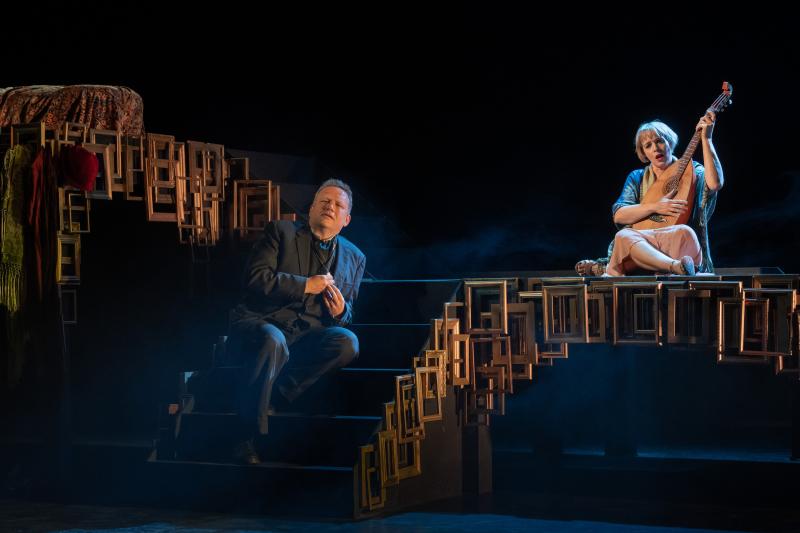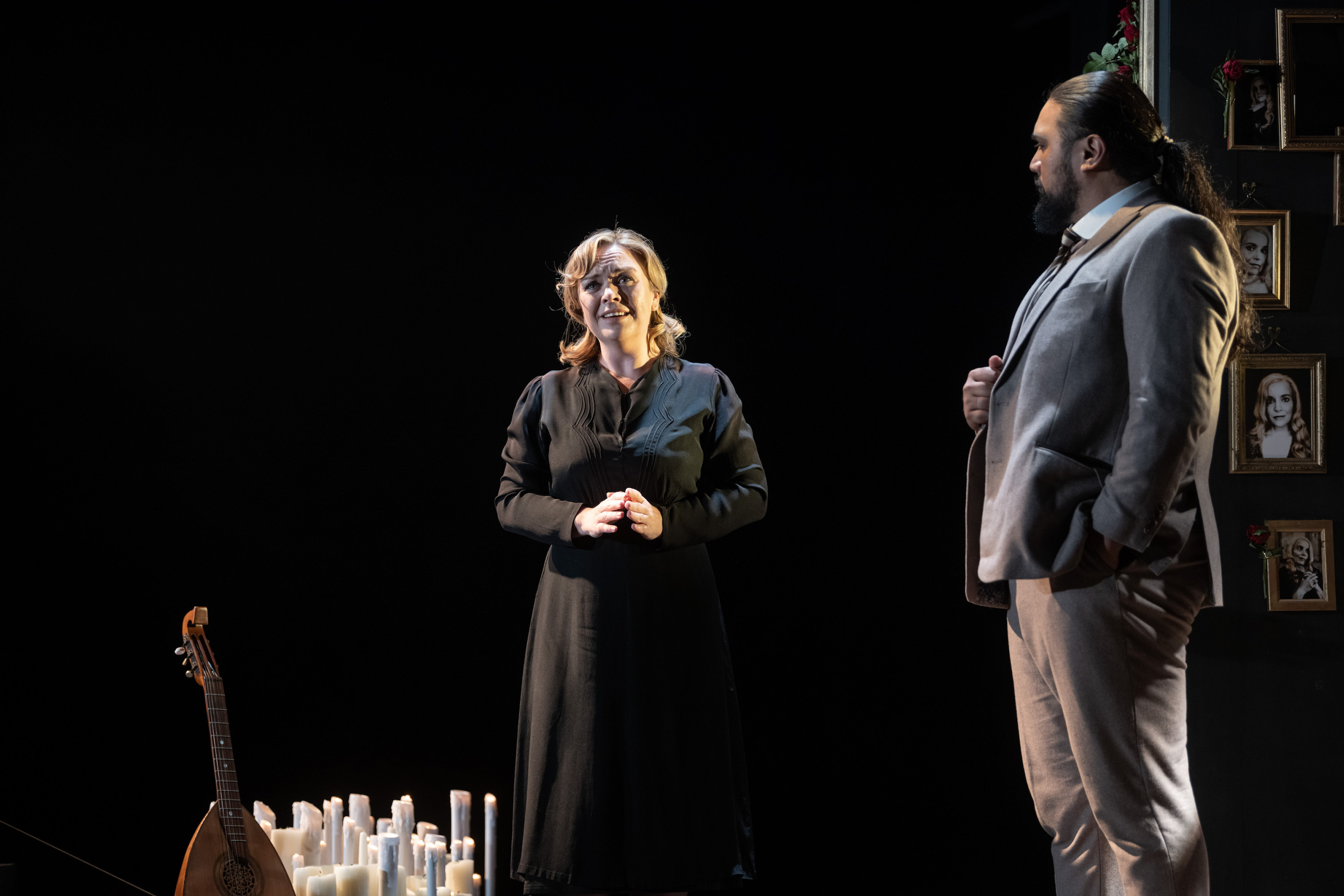Die tote Stadt, Longborough Festival review - Korngold on the way back | reviews, news & interviews
Die tote Stadt, Longborough Festival review - Korngold on the way back
Die tote Stadt, Longborough Festival review - Korngold on the way back
Brilliant 1920 opera that might have shown the way forward

Will Erich Korngold, the great cinema composer, ever be recognised as a great composer for the live theatre? Probably not, at least until the prejudices that did for him in his lifetime – the prejudice against film and popular music and the prejudice against Jews – are fully corrected in practice as well as in people’s minds. Korngold, happily, is on the way back, though it has taken a long time. Die tote Stadt should, if justice be done, clinch his return.
This terrific opera, first staged in Hamburg in 1920 when Korngold was 23, admittedly created its own problems from the start. It was the time of Cocteau’s “music I can live in like a house”, a music for papering the walls. If you papered the walls with Die tote Stadt (the Dead City – for some reason Bruges), it would keep you awake or give you nightmares. And in fact a nightmare of the most violent and psychotic variety forms its climactic episode and its most brilliant of several riveting confrontations.
Paul, the hero, has recently lost his young wife and is mentally imprisoned by memories of her, by her portrait (in Carmen Jakobi’s profoundly sensitive production a whole gallery of portraits in a house furnished with empty picture frames), and by a lock of her hair, which he keeps under a glass cover like a communion host. But one day he meets another girl so like his dead Marie that he at first imagines she is her, then – when this Marietta turns out to be a frivolous and promiscuous member of a troupe of actors – recognises that she is in fact out to destroy his fantasy love and bring him back to reality. In the nightmare scene of the final act, after they have made love, she taunts him with the lock of Marie’s hair and he in a rage strangles her with it. But the bad dream is exposed (also to the audience), and Marietta reappears, very much alive, then abandons Paul to his other, empty dream and the cold truth.
Korngold’s treatment of this subject has obvious echoes of pre-war Expressionism, of Strauss’s Elektra and Schoenberg’s Erwartung in particular. Musically, though there are quasi-atonal pages, it owes most to Strauss; its discourse is essentially Straussian. Musical horrors alternate with episodes of a warm, lyrical tonality that even at times recall Ariadne auf Naxos, albeit with digressions which show that Korngold also knew his Puccini. And Ariadne is plundered as well for aspects of dramaturgy; his street actors (pictured below), who have a rather too long scene in the middle of Act 2, are plainly cousins of Strauss’s commedia team. Marietta is Zerbinetta with a brain and a more subtle, less showy defining aria. Having said all this, Korngold’s music is entirely his own and an authentic evolution along post-romantic lines. It might have pointed a way forward for modern music if modernism itself hadn’t decreed otherwise. Its technical prowess is astonishing; its handling of a huge orchestra (cleverly reduced here by Leonard Eröd), and above all its writing for voices (if at times excessively strenuous) and its dramatic pacing are alike truly remarkable. One is carried along by the music’s sheer energy, by its inventive richness, and not least by its psychological conviction. These are vivid characters with real problems. Meanwhile the iconic significance for 1920 is inescapable: bury your dead and face the world as you find it. Whether Korngold followed this precept in his music is, of course, matter for discussion.
Having said all this, Korngold’s music is entirely his own and an authentic evolution along post-romantic lines. It might have pointed a way forward for modern music if modernism itself hadn’t decreed otherwise. Its technical prowess is astonishing; its handling of a huge orchestra (cleverly reduced here by Leonard Eröd), and above all its writing for voices (if at times excessively strenuous) and its dramatic pacing are alike truly remarkable. One is carried along by the music’s sheer energy, by its inventive richness, and not least by its psychological conviction. These are vivid characters with real problems. Meanwhile the iconic significance for 1920 is inescapable: bury your dead and face the world as you find it. Whether Korngold followed this precept in his music is, of course, matter for discussion.
Carmen Jakobi’s production (designer Nate Gibson) was originally intended as a semi-staging, and it retains something of the discretion that goes with that genre. The direction is crisp and to the point, and largely devoid of lapel-clutching “ideas”, though I remain slightly baffled by the procession of nuns who wander on in the final act – an echo perhaps of Meyerbeer’s Robert le diable, which Marietta is, she tells us, about to appear in as a dancer (and Meyerbeer’s nuns also, weirdly, rise from the grave and dance).
Above all, the cast is almost uniformly excellent. Rachel Nicholls, coming late to the role of Marietta, sings it with tremendous verve, perhaps mildly over-playing the flibbertigibbet at first, but catching beautifully the complexity of the character as she does battle with Paul’s impenetrable delusions. Peter Auty also finds the genuine neurosis in Paul’s nature while singing with remarkable stamina and athleticism a part that would bring most tenors to their knees. The interaction of these two, which is the core of the work, I found consistently moving. But it must be said that the best, purest singing, as such, came from Stephanie Windsor-Lewis in the not quite small nor quite big enough part of the housekeeper Brigitta (pictured below with Benson Wilson as Frank), who starts the work off like Strauss’s Marschallin reduced to service, but then more or less vanishes from the opera. The street players (Luci Briginshaw, Benson Wilson, Alexander Sprague and Lee David Bowen) may go on too long but are good enough to cover the composer’s tracks. They move well on this tight stage (movement by Elaine Brown), and sing brightly, and Wilson, as Pierrot, has perhaps the prettiest song in the whole work, if not exactly the prettiest voice. But his Frank (Paul’s friend) is a good foil, vocally sturdy, a sensible presence till he himself falls for Marietta and out with Paul.
The street players (Luci Briginshaw, Benson Wilson, Alexander Sprague and Lee David Bowen) may go on too long but are good enough to cover the composer’s tracks. They move well on this tight stage (movement by Elaine Brown), and sing brightly, and Wilson, as Pierrot, has perhaps the prettiest song in the whole work, if not exactly the prettiest voice. But his Frank (Paul’s friend) is a good foil, vocally sturdy, a sensible presence till he himself falls for Marietta and out with Paul.
Justin Brown conducts with superb command of this, when all is said and done, complex and difficult score, and with great precision of ensemble between orchestra and stage. This is an important event, and a big feather in Longborough’s already well-feathered cap.
rating
Explore topics
Share this article
The future of Arts Journalism
You can stop theartsdesk.com closing!
We urgently need financing to survive. Our fundraising drive has thus far raised £49,000 but we need to reach £100,000 or we will be forced to close. Please contribute here: https://gofund.me/c3f6033d
And if you can forward this information to anyone who might assist, we’d be grateful.

Subscribe to theartsdesk.com
Thank you for continuing to read our work on theartsdesk.com. For unlimited access to every article in its entirety, including our archive of more than 15,000 pieces, we're asking for £5 per month or £40 per year. We feel it's a very good deal, and hope you do too.
To take a subscription now simply click here.
And if you're looking for that extra gift for a friend or family member, why not treat them to a theartsdesk.com gift subscription?
more Opera
 La bohème, Opera North review - still young at 32
Love and separation, ecstasy and heartbreak, in masterfully updated Puccini
La bohème, Opera North review - still young at 32
Love and separation, ecstasy and heartbreak, in masterfully updated Puccini
 Albert Herring, English National Opera review - a great comedy with depths fully realised
Britten’s delight was never made for the Coliseum, but it works on its first outing there
Albert Herring, English National Opera review - a great comedy with depths fully realised
Britten’s delight was never made for the Coliseum, but it works on its first outing there
 Carmen, English National Opera review - not quite dangerous
Hopes for Niamh O’Sullivan only partly fulfilled, though much good singing throughout
Carmen, English National Opera review - not quite dangerous
Hopes for Niamh O’Sullivan only partly fulfilled, though much good singing throughout
 Giustino, Linbury Theatre review - a stylish account of a slight opera
Gods, mortals and monsters do battle in Handel's charming drama
Giustino, Linbury Theatre review - a stylish account of a slight opera
Gods, mortals and monsters do battle in Handel's charming drama
 Susanna, Opera North review - hybrid staging of a Handel oratorio
Dance and signing complement outstanding singing in a story of virtue rewarded
Susanna, Opera North review - hybrid staging of a Handel oratorio
Dance and signing complement outstanding singing in a story of virtue rewarded
 Ariodante, Opéra Garnier, Paris review - a blast of Baroque beauty
A near-perfect night at the opera
Ariodante, Opéra Garnier, Paris review - a blast of Baroque beauty
A near-perfect night at the opera
 Cinderella/La Cenerentola, English National Opera review - the truth behind the tinsel
Appealing performances cut through hyperactive stagecraft
Cinderella/La Cenerentola, English National Opera review - the truth behind the tinsel
Appealing performances cut through hyperactive stagecraft
 Tosca, Royal Opera review - Ailyn Pérez steps in as the most vivid of divas
Jakub Hrůša’s multicoloured Puccini last night found a soprano to match
Tosca, Royal Opera review - Ailyn Pérez steps in as the most vivid of divas
Jakub Hrůša’s multicoloured Puccini last night found a soprano to match
 Tosca, Welsh National Opera review - a great company reduced to brilliance
The old warhorse made special by the basics
Tosca, Welsh National Opera review - a great company reduced to brilliance
The old warhorse made special by the basics
 BBC Proms: The Marriage of Figaro, Glyndebourne Festival review - merriment and menace
Strong Proms transfer for a robust and affecting show
BBC Proms: The Marriage of Figaro, Glyndebourne Festival review - merriment and menace
Strong Proms transfer for a robust and affecting show
 BBC Proms: Suor Angelica, LSO, Pappano review - earthly passion, heavenly grief
A Sister to remember blesses Puccini's convent tragedy
BBC Proms: Suor Angelica, LSO, Pappano review - earthly passion, heavenly grief
A Sister to remember blesses Puccini's convent tragedy
 Orpheus and Eurydice, Opera Queensland/SCO, Edinburgh International Festival 2025 review - dazzling, but distracting
Eye-popping acrobatics don’t always assist in Gluck’s quest for operatic truth
Orpheus and Eurydice, Opera Queensland/SCO, Edinburgh International Festival 2025 review - dazzling, but distracting
Eye-popping acrobatics don’t always assist in Gluck’s quest for operatic truth

Add comment